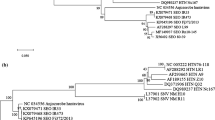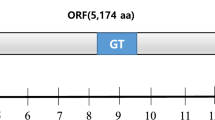Summary
The hantavirus strain Vranica was previously reported to have been isolated from a bank vole in Bosnia-Hercegovina and associated with the occurrence of hemorrhagic fever with renal syndrome (HRFS) in humans. The complete cDNA nucleotide sequences of the small (S) and medium (M) genomic RNA segments of this virus were determined. Major open reading frames were found in the S and M segment between nucleotide positions 43 and 1341 coding for a polypeptide of 433 amino acid residues and between nucleotide positions 41 and 3 484 coding for 1 148 amino acid residues, respectively. The analysis and the alignment of the nucleotide and the derived amino acid sequences with known sequences of other hantavirus strains demonstrate that Vranica resembles Swedish strains and represents a new virus subtype of the Puumala serotype distinct from the subtypes represented by virus strains CG18–20 and Sotkamo.
Similar content being viewed by others
References
Arikawa J, Lapenotiere HF, Iacono-Connors L, Wang M, Schmaljohn CS (1990) Coding properties of the S and M genome segments of Sapporo rat virus: comparison to other causative agents of hemorrhagic fever with renal syndrome. Virology 176: 114–125
Arthur RR, Lofts RS, Gomez J, Glass GE, LeDuc JW, Childs JE (1992) Grouping of hantaviruses by small (s) genome segment polymerase chain reaction and amplification of viral RNA from wild-caught rats. Am J Trop Med Hyg 47: 210–224
Baek LJ, Yanagihara R, Gibbs CJ, Miyazaki M, Gajdusek DC (1988) Leaky virus: a new hantavirus isolated fromMus musculus in the United States. J Gen Virol 69: 3129–3132
Chirgwin JM, Pryzybyla AE, MacDonald DJ, Rutter WJ (1979) Isolation of biologically active ribonucleic acid from sources enriched in ribonuclease. Biochemistry 18: 5294–5295
Chu YK, Rossi C, LeDuc JW, Lee HW, Schmalijohn CS, Dalrymple JM (1994) Serological relationships among viruses in the hantavirus genus, familyBunyaviridae. Virology 198: 196–204
Diglisic G, Xiao SY, Gligic A, Obradovic M, Stojanovic R, Velimirovic D, Lukac V, Rossi CA, LeDuc JW (1994) Isolation of a Puumala-like virus fromMus musculus captured in Yugoslavia and its association with severe hemorrhagic fever with renal syndrome. J Infect Dis 169: 204–207
Duchin JS, Koster FT, Peters CJ, Simpson GL, Tempest B, Zaki SR, Ksiazek TG, Rollin PE, Nichol S, Umland ET, Moolenaar RL, Reef SE, Nolte KB, Gallaher MM, Butler JC, Breimann RF et al. (1994) Hantavirus pulmonary syndrome: a clinical description of 17 patients with a newly recognized disease. N Engl J Med 330: 949–955
Giebel LB, Raab K, Zöller L, Bautz EKF, Darai G (1991) Identification and characterization of a Hantavirus strain of unknown origin by nucleotide sequence analysis of the cDNA derived from the viral S RNA segment. Virus Genes 5: 11–120
Giebel LB, Stohwasser R, Zöller L, Bautz EKF, Darai G (1989) Determination of the coding capacity of the M genome segment of Nephropathia epidemica virus strain Hällnäs B1 by molecular cloning and nucleotide sequence analysis. Virology 172: 498–505
Gligic A, Frusic M, Obradovic M, Stojanovic R, Hlaca D, Gibbs CJ, Yanagihara R, Calisher CH, Gajdusek DC (1989) Hemorrhagic fever with renal syndrome in Yugoslavia: antigenic characterization of hantaviruses isolated fromApodemus flavicollis andClethrionomys glareolus. Am J Trop Med Hyg 41: 109–115
Gligic A, Obradovic M, Stojanovic R, Vujosevic N, Ovcaric A, Frusic M, Gibbs CJ, Calisher CH, Gajdusek DC (1989) Epidemic hemorrhagic fever with renal syndrome in Yugoslavia, 1986. Am J Trop Med Hyg 41: 102–108
Gligic A, Stojanovic R, Obradovic M, Hlaca D, Dimkovic N, Diglisic G, Lukac V, Ler Z, Bogdanovic R, Antonijevic B, Ropac B, Avsic-Zupanc T, LeDuc JW, Ksiazek T, Yanagihara R, Gajdusek DC (1992) Hemorrhagic fever with renal syndrome in Yugoslavia: epidemiologic and epizootiologic features of a nationwide outbreak in 1989. Eur J Epidemiol 8: 816–825
Groen J, Dalrymple J, Fisher-Hoch S, Jordans JGM, Clement JP, Osterhaus ADME (1992) Serum antibodies to structural proteins of hantavirus arise at different times after infection. J Med Virol 37: 283–287
Heijne G von (1983) Patterns of amino acids near signal-sequence cleavage sites. Eur J Biochem 133: 17–21
Hjelle B, Jenison S, Torrez-Martinez N, Yamada T, Nolte K, Zumwalt R, MacInnes K, Myers G (1994) A novel hantavirus associated with an outbreak of fatal respiratory disease in the Southwestern United States: evolutionary relationship to known hantaviruses. J Virol 68: 592–596
Hopp TP, Woods KR (1981) Prediction of protein antigenic determinants from amino acid sequences. Proc Natl Acad Sci USA 78: 3824–3828
Isegawa Y, Tanishita O, Ueda S, Yamanishi K (1994) Association of serine in position 1124 of Hantaan virus glycoprotein with virulence in mice. J Gen Virol 75: 3273–3278
LeDuc JW, Childs JE, Glass GE (1992) The hantaviruses, etiologic agents of hemorrhagic fever with renal syndrome: a possible cause of hypertension and chronic renal disease in the United States. Annu Rev Public Health 13: 79–98
Lee HW, van der Groen G (1989) Hemorrhagic fever with renal syndrome. In: Melnick JL (ed) Progress in medical virology, vol 36. Karger, Basel, pp 62–102
Lee PW, Gibbs CJ, Gajdusek D, Yanagihara R (1985) Serotypic classification of hantaviruses by indirect immuno-fluorescent antibody and plaque reduction neutralization tests. J Clin Microbiol 22: 940–944
Nichol ST, Spiropoulou CS, Morzunov S, Rollin PE, Ksiazek TG, Feldmann H, Sanchez A, Childs J, Zaki S, Peters CJ (1993) Genetic identification of a hantavirus associated with an outbreak of acute respiratory illness. Science 262: 914–916
Parrington MA, Kang CY (1990) Nucleotide sequence analysis of the S genomic segment of Prospect Hill virus: comparison with the prototype hantavirus. Virology 175: 167–175
Pilaski J, Feldmann H, Morzunov S, Rollin PE, Ruo SL, Lauer B, Peters CJ, Nichol ST (1994) Genetic identification of a new virus strain causing severe hemorrhagic fever with renal syndrome in Germany. J Infect Dis 170: 1456–1462
Plyusnin A, Vapalahti O, Lankinen H, Lehväslaiho H, Apekina N, Myasnikov Y, KallioKokko H, Henttonen H, Lundkvist A, Brummer-Korvenkontio M, Gavrilovskaya I, Vaheri A (1994) Tula virus: a newly detected hantavirus carried by European common voles. J Virol 68: 7833–7839.
Plyusnin A, Vapalahti O, Ulfves K, Lehväslaiho H, Apekina N, Gavrilovskaya I, Blinov V, Vaheri A (1994) Sequences of wild Puumala virus genes show a correlation of genetic variation with geographic origin of the strains. J Gen Virol 75: 405–409
Puthavathana P, Dobbs M, Baek LJ, Chu YK, Lee HW, Kang CY (1993) Comparison of nucleotide sequences among hantaviruses belonging to the same serotype: an analysis of amplified DNA by thermal cycle sequencing. Virus Res 30: 161–169
Rao MJK, Argos P (1986) A conformational preference parameter to predict helices in integral membrane proteins. Biochim Biophys Acta 869: 197–214
Sanger F, Nicklen S, Coulson AR (1977) DNA sequencing with chain terminating inhibitors. Proc Natl Acad Sci USA 74: 5463–5467
Schmaljohn CS, Dalrymple JM (1983) Analysis of Hantaan virus RNA: evidence for a new genus ofBunyaviridae. Virology 131: 482–491
Schmaljohn CS, Hasty SE, Dalrymple JM, LeDuc JW, Lee HW, von Bornsdorff CH, Brummer-Korvenkontio M, Vaheri A, Tsai TF, Regnery HL, Goldbagger D, Lee PW (1985) Antigenic and genetic properties of viruses linked to haemorrhagic fever with renal syndrome. Science 227: 1041–1044
Schmaljohn CS, Jennings GB, Hay J, Dalrymple JM (1986) Coding strategy of the S genome segment of Hantaan virus. Virology 155: 633–643
Schmaljohn CS, Schmaljohn AL, Dalrymple JM (1987) Hantaan virus M RNA: coding strategy, nucleotide sequence, and gene order. Virology 157: 31–39
Sibold C, Sparr S, Schulz A, Labuda M, Kozuch O, Lysy J, Krüger DH, Meisel H (1995) Genetic characterization of a new hantavirus detected inMicrotus arvalis from Slovakia. Virus Genes 9 (in press)
Spiropoulou CF, Morzunov S, Feldmann H, Sanchez A, Peters CJ, Nichol ST (1994) Genome structure and variability of a virus causing hantavirus pulmonary syndrome. Virology 200: 715–723
Stohwasser R, Giebel LB, Raab K, Bautz EKF, Darai G (1992) Polymerase chain reaction for detection of hantaviruses. In: Becker J, Darai G (eds) Diagnosis of human viruses by polymerase chain reaction (PCR) technology. Springer, Berlin Heidelberg New York, Tokyo, pp 372–388 (Frontiers of Virology)
Stohwasser R, Giebel LB, Zöller L, Bautz EKF, Darai G (1990) Molecular characterization of the RNA S segment of Nephropathia Epidemica virus strain Hällnäs B1. Virology 174: 79–86
Taller AM, Xiao SY, Godec MS, Gligic A, Avsic-Zupanc T, Goldfarb LG, Yanagihara R, Asher DM (1993) Belgrade virus, a cause of hemorrhagic fever with renal syndrome in the Balkans, is closely related to Dobrava virus of field mice. J Infect Dis 168: 750–753
Tkachenko EA, Bashkiritsev VN, van der Groen G, Dzagurova TK, Ivanov AP, Ryltseva EV (1984) Isolation in Vero E6 cells of hantavirus fromClethrionomys glareolus captured in Bashkiria area of the USSR. Ann Soc Belg Med Trop 64: 425–426
Vapalahti O, Kallio-Kokko H, Salonen EM, Brummer-Korvenkontio M, Vaheri A (1992) Cloning and sequencing of Puumala virus Sotkamo strain S and M RNA segments: evidence for strain variation in hantaviruses and expression of the nucleocapsid protein. J Gen Virol 73: 829–838
Xiao SY, LeDuc JW, Chu YK, Schmaljohn CS (1994) Phylogenetic analysis of virus isolates in the genus hantavirus, family Bunyaviridae. Virology 198: 205–217
Xiao SY, Spik KW, Li D, Schmaljohn CS (1993) Nucleotide and deduced amino acid sequences of the M and S genome segments of two Puumala virus isolates from Russia. Virus Res 30: 97–103
Yanagihara R, Gajdusek DC (1987) Hemorrhagic fever with renal syndrome: global epidemiology and ecology of hantavirus infections. In: de la Maza LM, Peterson EM (eds) Medical virology VI. Elsevier, Amsterdam, pp 171–214
Yanagihara R, Svedmyr A, Amyx HL, Lee PW, Goldgaber D, Gajdusek DC, Gibbs CJ, Nystrom K (1984) Isolation and propagation of nephropathia epidemica virus in bank voles. Scand J Infect Dis 16: 225–228
Zöller L, Faulde M, Meisel H, Ruh B, Kimming P, Schelling U, Zeier M, Kulzer P, Becker C, Roggendorf M, Bautz EKF, Krüger DH, Darai G (1995) Seroprevalence of hantavirus antibodies in Germany as determined by a novel recombinant ELISA. Eur J Clin Microbiol Infect Dis 14: 305–313
Zöller L, Scholz J, Stohwasser R, Giebel LB, Sethi KK, Bautz EKF, Darai G (1989) Immunoblot analysis of the serological response in Hantavirus infections. J Med Virol 27: 231–237
Author information
Authors and Affiliations
Additional information
The nucleotide sequence data reported in this paper have been deposited in Gen Bank under accession numbers U14137 and U14136.
Rights and permissions
About this article
Cite this article
Reip, A., Haring, B., Sibold, C. et al. Coding strategy of the S and M genomic segments of a hantavirus representing a new subtype of the Puumala serotype. Archives of Virology 140, 2011–2026 (1995). https://doi.org/10.1007/BF01322689
Received:
Accepted:
Issue Date:
DOI: https://doi.org/10.1007/BF01322689




